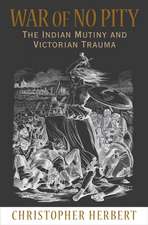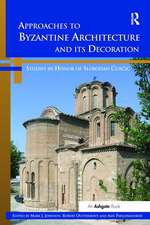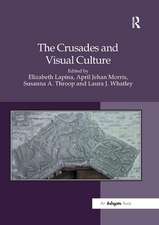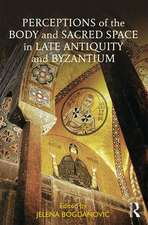Foreshadowing the Reformation: Art and Religion in the 15th Century Burgundian Netherlands
Autor Christopher Herberten Limba Engleză Paperback – 15 iun 2018
| Toate formatele și edițiile | Preț | Express |
|---|---|---|
| Paperback (1) | 304.27 lei 6-8 săpt. | |
| Taylor & Francis – 15 iun 2018 | 304.27 lei 6-8 săpt. | |
| Hardback (1) | 819.09 lei 6-8 săpt. | |
| Taylor & Francis – 11 iul 2016 | 819.09 lei 6-8 săpt. |
Preț: 304.27 lei
Preț vechi: 343.96 lei
-12% Nou
Puncte Express: 456
Preț estimativ în valută:
58.23€ • 60.57$ • 48.07£
58.23€ • 60.57$ • 48.07£
Carte tipărită la comandă
Livrare economică 14-28 aprilie
Preluare comenzi: 021 569.72.76
Specificații
ISBN-13: 9781138481350
ISBN-10: 1138481351
Pagini: 176
Ilustrații: 20 Illustrations, color
Dimensiuni: 152 x 229 x 15 mm
Greutate: 0.68 kg
Ediția:1
Editura: Taylor & Francis
Colecția Routledge
Locul publicării:Oxford, United Kingdom
ISBN-10: 1138481351
Pagini: 176
Ilustrații: 20 Illustrations, color
Dimensiuni: 152 x 229 x 15 mm
Greutate: 0.68 kg
Ediția:1
Editura: Taylor & Francis
Colecția Routledge
Locul publicării:Oxford, United Kingdom
Public țintă
PostgraduateCuprins
1. Foreshadowing the Reformation
2. An Overture to the Themes of the Book: Robert Campin: The Dijon Nativity
3. Religion and Art in the Service of the Burgundian Dynasty
4. Funerary Monuments and Entombment Groups: Religion and Art in Large Format
5. Books of Hours: Religion and Art in Small Format
6. Religious Belief and Practice
7. The Devotio Moderna
8. Paradoxes of Time and Place: Robert Campin: The Mérode Altarpiece
9. Political Power in a Theological Setting: Jan van Eyck: The Rolin Madonna
10. The Beauty of the Divine Drama: Jan van Eyck: The Ghent Altarpiece
11. Death and Salvation: Rogier van der Weyden: The Beaune Last Judgement
12. A Turning Point? Rogier van der Weyden: The Prado Deposition
13. The Individual’s Destiny? Hans Memling: The Last Judgement
14. Enriching Imagination: Hans Memling: Scenes from the Passion of Christ
15. Individual Devotion: Hans Memling: Christ at the Column
16. Concentrating on the Individual: Three Portraits and the Holy Face
17. Conclusions
2. An Overture to the Themes of the Book: Robert Campin: The Dijon Nativity
3. Religion and Art in the Service of the Burgundian Dynasty
4. Funerary Monuments and Entombment Groups: Religion and Art in Large Format
5. Books of Hours: Religion and Art in Small Format
6. Religious Belief and Practice
7. The Devotio Moderna
8. Paradoxes of Time and Place: Robert Campin: The Mérode Altarpiece
9. Political Power in a Theological Setting: Jan van Eyck: The Rolin Madonna
10. The Beauty of the Divine Drama: Jan van Eyck: The Ghent Altarpiece
11. Death and Salvation: Rogier van der Weyden: The Beaune Last Judgement
12. A Turning Point? Rogier van der Weyden: The Prado Deposition
13. The Individual’s Destiny? Hans Memling: The Last Judgement
14. Enriching Imagination: Hans Memling: Scenes from the Passion of Christ
15. Individual Devotion: Hans Memling: Christ at the Column
16. Concentrating on the Individual: Three Portraits and the Holy Face
17. Conclusions
Recenzii
"...his combination of solid art-historical scholarship, theological insights and an enviable ability to ‘read’ a painting in both detail and depth is very rewarding indeed.(...) This excellent book must also be commended as an invaluable, and portable, accessory to viewing such artworks in situ."
- Graham Howes, Trinity Hall, Cambridge in Theology journal, issue 120.3 (May/June) 2017
- Graham Howes, Trinity Hall, Cambridge in Theology journal, issue 120.3 (May/June) 2017
Descriere
If we are to fully understand and appreciate the late Medieval and Renaissance paintings of great Northern European artists, we need to investigate the religious and spiritual beliefs and practices of the time. It has been quite fashionable over recent decades largely to ignore the contemporary religious context and to concentrate instead on the part played by economics in the creation of works of art. This book argues that there was a symbiotic relationship between those artistic and spiritual worlds and that by bringing the insights from those worlds together we can get a much richer appreciation of medieval life.













